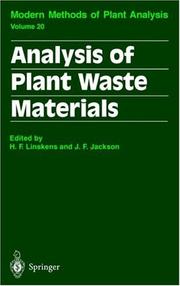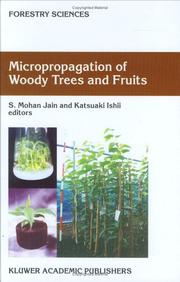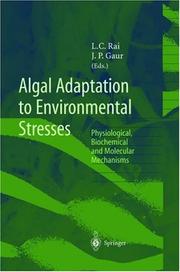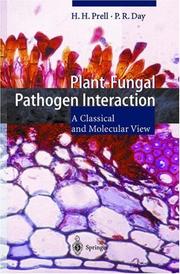| Listing 1 - 9 of 9 |
Sort by
|


ISBN: 0792355822 9048151740 9401591431 Year: 1999 Publisher: Dordrecht : Springer Netherlands : Imprint: Springer,
Abstract | Keywords | Export | Availability | Bookmark
 Loading...
Loading...Choose an application
- Reference Manager
- EndNote
- RefWorks (Direct export to RefWorks)
Mongolia is an expansive land-locked country, tilted by tectonic forces to the North, that experiences extremes of continental climate. Moisture-carrying wind currents are scarce so that the land has extended highs and lows in its environment. Culturally the people are mostly nomadic, having been sustained for centuries by an economy based on domestic livestock grazing. There is a saying that, `As the noses go, so goes Mongolia', referring to the domesticated grazing noses of sheep, goats, camels, yaks or horses, and wild ungulates such as gazelles. The vast fenceless steppes of Mongolia furnish the vegetation for grazing. With such extremes in climate it is clear that the vegetation must be resilient and dynamic to cope with the dictates of its extremely harsh environments. Pollen profiles from lakes, plant macrofossils and other data over the last 15,000 years show the dynamic nature of Mongolian vegetation. Currently Mongolian society is experiencing much human-driven economic development which increases pressure on its vegetation. The Great Khural Laws of 1995 forcefully addressed such environmental concerns with the expanded establishment of National Reserves and Parks. But continued effort and vigilance must be expended to insure that Mongolian society will continue to be sustained by its vegetation. This book highlights work such as conserving and restoring plant diversity in various ecosystems and makes recommendations for sustaining the vegetation basis of the nomadic Mongolian society.
Mongolia --- vegetation dynamics --- vegetation history --- vegetation management --- nature conservation --- Plant physiology. --- Plant ecology. --- Biochemistry. --- Ecotoxicology. --- Atmospheric sciences. --- Hydrogeology. --- Plant Physiology. --- Plant Ecology. --- Biochemistry, general. --- Atmospheric Sciences. --- Geohydrology --- Geology --- Hydrology --- Groundwater --- Atmospheric sciences --- Earth sciences --- Atmosphere --- Ecotoxicology --- Pollutants --- Pollution --- Environmental health --- Toxicology --- Biological chemistry --- Chemical composition of organisms --- Organisms --- Physiological chemistry --- Biology --- Chemistry --- Medical sciences --- Botany --- Phytoecology --- Plants --- Vegetation ecology --- Ecology --- Physiology --- Composition --- Floristic ecology

ISBN: 3540646698 3642084311 3662038870 Year: 1999 Publisher: Berlin : Springer,
Abstract | Keywords | Export | Availability | Bookmark
 Loading...
Loading...Choose an application
- Reference Manager
- EndNote
- RefWorks (Direct export to RefWorks)
Modern Methods of Plant Analysis When the handbook Modern Methods of Plant Analysis, was first introduced in 1954, the considerations were: 1. the dependence of scientific progress in biology on the improvement of existing and the introduction of new methods; 2. the difficulty in finding many new analytical methods in specialized journals which are normally not accessible to experimental plant biologists; 3. the fact that in the methods sections of papers the description of methods is frequently so compact, or even sometimes so incomplete, that it is difficult to reproduce experiments. These considerations still stand today. The series was highly successful, seven volumes appearing between 1956 and 1964. Since there is still today a demand for the old series, the publisher has decided to resume publication of Modern Methods of Plant Analysis. It is hoped that the New Series will be just as acceptable to those working in plant sciences and related fields as the early volumes undoubtedly were. It is difficult to single out the major reasons for the success of any publication, but we believe that the methods published in the first series were up-to-date at the time and presented in a way that made description, as applied to plant material, complete in itself with little need to consult other publications. Contribution authors have attempted to follow these guidelines in this New Series of volumes. Editorial The earlier series of Modern Methods of Plant Analysis was initiated by Michel V.
Agrotechnology and Food Sciences. Engineering --- Waste treatment --- biochemistry --- decomposition --- measurements --- organic waste --- plant analysis --- uses --- Waste treatment. --- Biochemistry. --- Food—Biotechnology. --- Analytical chemistry. --- Plant science. --- Botany. --- Biochemistry, general. --- Food Science. --- Analytical Chemistry. --- Plant Sciences. --- Botanical science --- Phytobiology --- Phytography --- Phytology --- Plant biology --- Plant science --- Biology --- Natural history --- Plants --- Analysis, Chemical --- Analytic chemistry --- Chemical analysis --- Chemistry, Analytic --- Chemistry --- Biological chemistry --- Chemical composition of organisms --- Organisms --- Physiological chemistry --- Medical sciences --- Composition --- Floristic botany --- Forest litter --- Organic wastes --- Plant products industry --- Biodegradation. --- Analysis. --- Waste disposal. --- Agricultural industries --- Garbage --- Wastes, Organic --- Factory and trade waste --- Refuse and refuse disposal --- Sewage --- Waste products --- Biodegradation

ISBN: 1402011350 940103964X 9401001251 Year: 2003 Publisher: Dordrecht ; Boston : Kluwer Academic Publishers,
Abstract | Keywords | Export | Availability | Bookmark
 Loading...
Loading...Choose an application
- Reference Manager
- EndNote
- RefWorks (Direct export to RefWorks)
Global warming, environmental changes, water shortage, and sustainable development are the most up-to-date issues, which have challenged mankind. Researchers worldwide are engaged in addressing some of these problems, including reduction in carbon dioxide accumulation, and enrichment of perennial woody species on the terrestrial ecosystem. About 12 million hectares of the world's forests disappear every year. By 2025, the world population will reach 7. 5 billion, and the forest area will be reduced to well below 50 % of the current area. Reforestation is an important to prevent the loss of forest resources including timber, biodiversity and water resources. Therefore, subsequent volume of reforestation over the deforested land should be followed to safeguard the forests and maintain its size, which will require a continuous supply of planting material. Similarly fruit trees, including tropical and subtropical fruit trees, are consumed both as fresh and in the processed form including juices, beverages, and dried fruits. They are an important source of nutrition e. g. rich in vitamins, sugars, aromas and flavour compounds, and raw material for food processing industries. The production, cultivation and maintenance of tree species provide highly sustainable production systems that conserve soils, microenvironment and biodiversity. Fruit trees have longjuvenile periods and large tree size. In many fruit trees e. g. avocado and others controlled crosses are difficult to make due to massive fruit drop.
Fruit --- Trees --- Woody plants --- Basic Sciences. Biotechnology --- Micropropagation. --- Plant genetics. --- Forestry. --- Plant science. --- Botany. --- Biochemistry. --- Trees. --- Plant Genetics and Genomics. --- Science, Humanities and Social Sciences, multidisciplinary. --- Plant Sciences. --- Biochemistry, general. --- Tree Biology. --- Dendrology --- Nursery stock --- Arboriculture --- Forests and forestry --- Timber --- Biological chemistry --- Chemical composition of organisms --- Organisms --- Physiological chemistry --- Biology --- Chemistry --- Medical sciences --- Botanical science --- Phytobiology --- Phytography --- Phytology --- Plant biology --- Plant science --- Natural history --- Plants --- Forest land --- Forest lands --- Forest planting --- Forest production --- Forest sciences --- Forestation --- Forested lands --- Forestland --- Forestlands --- Forestry --- Forestry industry --- Forestry sciences --- Land, Forest --- Lands, Forest --- Silviculture --- Sylviculture --- Woodlands --- Woods (Forests) --- Agriculture --- Natural resources --- Afforestation --- Logging --- Tree crops --- Genetics --- Composition --- Floristic botany
Periodical
Abstract | Keywords | Export | Availability | Bookmark
 Loading...
Loading...Choose an application
- Reference Manager
- EndNote
- RefWorks (Direct export to RefWorks)
General biophysics --- General biochemistry --- Biochemistry --- Biophysics --- Biochimie --- Biophysique --- periodicals. --- Periodicals. --- Périodiques --- Biochemistry. --- Biophysics. --- #TS:KOMA --- 57 --- 577.1 --- 577.3 --- Mechanobiology --- Biological sciences in general --- Chemical bases of life. Biochemistry and bio-organic chemistry generally --- Physical and physicochemical bases of life. Biophysics. Biophysical chemistry in general --- Periodicals --- Chemistry --- Organic Chemistry --- Genetics --- Immunology --- Neurology --- Health Sciences. --- Life Sciences. --- Health Sciences --- Life Sciences --- Biology --- General and Others --- ONLY SEPARATES (no collection) --- USA --- biochemistry --- biophysics --- periodical --- Chemistry. --- 577.3 Physical and physicochemical bases of life. Biophysics. Biophysical chemistry in general --- 577.1 Chemical bases of life. Biochemistry and bio-organic chemistry generally --- biochemie --- Périodiques --- EJBIOMO ELSEVIER-E EPUB-ALPHA-B EPUB-PER-FT --- Biological physics --- Biological chemistry --- Chemical composition of organisms --- Organisms --- Physiological chemistry --- Composition --- Medical sciences --- Physics --- Biochemie. --- Biofysica. --- MDBIOPHY MDBIOCHE --- Biochimie. --- Biophysique. --- biochemistry.

ISBN: 3540419381 3642639968 3642594913 Year: 2001 Publisher: New York, NY ; Berlin : Springer-Verlag,
Abstract | Keywords | Export | Availability | Bookmark
 Loading...
Loading...Choose an application
- Reference Manager
- EndNote
- RefWorks (Direct export to RefWorks)
Algae, generally held as the principal primary producers of aquatic systems, inhabit all conceivable habitats. They have great ability to cope with a harsh environment, e.g. extremely high and low temperatures, suboptimal and supraoptimal light intensities, low availability of essential nutrients and other resources, and high concentrations of toxic chemicals, etc. A multitude of physiological, biochemical, and molecular strategies enable them to survive and grow in stressful habitats. This book presents a critical account of various mechanisms of stress tolerance in algae, many of which may occur in microbes and plants as well.
Algae --- Algues --- ALG Algae --- biochemistry --- light --- nutrients --- pesticides --- physiology --- stress --- temperature --- Plant science. --- Botany. --- Ecology . --- Water pollution. --- Biochemistry. --- Microbiology. --- Plant Sciences. --- Ecology. --- Waste Water Technology / Water Pollution Control / Water Management / Aquatic Pollution. --- Biochemistry, general. --- Microbial biology --- Biology --- Microorganisms --- Biological chemistry --- Chemical composition of organisms --- Organisms --- Physiological chemistry --- Chemistry --- Medical sciences --- Aquatic pollution --- Fresh water --- Fresh water pollution --- Freshwater pollution --- Inland water pollution --- Lake pollution --- Lakes --- Reservoirs --- River pollution --- Rivers --- Stream pollution --- Water contamination --- Water pollutants --- Water pollution --- Pollution --- Waste disposal in rivers, lakes, etc. --- Balance of nature --- Bionomics --- Ecological processes --- Ecological science --- Ecological sciences --- Environment --- Environmental biology --- Oecology --- Environmental sciences --- Population biology --- Botanical science --- Phytobiology --- Phytography --- Phytology --- Plant biology --- Plant science --- Natural history --- Plants --- Composition --- Ecology --- Floristic botany --- ALGAE --- ENVIRONMENTAL FACTORS --- ECOPHYSIOLOGY --- ADAPTATION --- STRESS RESPONSE

ISBN: 354065609X 3642084907 3662068273 9783540656098 Year: 1999 Publisher: New York, NY ; Berlin : Springer-Verlag,
Abstract | Keywords | Export | Availability | Bookmark
 Loading...
Loading...Choose an application
- Reference Manager
- EndNote
- RefWorks (Direct export to RefWorks)
Mycorrhiza - the symbiosis between plants and fungi - plays a key role in plant life. This book reviews for the first time the current knowledge of 15 individual genera of ectomycorrhizal fungi. It is unique in that each chapter is dedicated to a single fungal genus, each written by internationally recognized experts on the respective fungal genera. It is thus an invaluable reference source for researchers, students and practitioners in the fields of mycorrhizal biology, mycology, forestry, plant sciences and soil biology.
Ectomycorrhizal fungi --- FUN Fungi & Lichenes --- Amanita --- Cantharellus --- Cenococcum --- Fungi --- Hebeloma --- Hysterangium --- Laccaria --- Lactarius --- Paxillus --- Pisolithus --- Rhizopogon --- Scleroderma --- Suillus --- Telephora --- Tuber --- handbooks --- mycorrhizae --- techniques --- Plant science. --- Botany. --- Agriculture. --- Forestry. --- Microbiology. --- Biochemistry. --- Plant Sciences. --- Biochemistry, general. --- Biological chemistry --- Chemical composition of organisms --- Organisms --- Physiological chemistry --- Biology --- Chemistry --- Medical sciences --- Microbial biology --- Microorganisms --- Forest land --- Forest lands --- Forest planting --- Forest production --- Forest sciences --- Forestation --- Forested lands --- Forestland --- Forestlands --- Forestry --- Forestry industry --- Forestry sciences --- Land, Forest --- Lands, Forest --- Silviculture --- Sylviculture --- Woodlands --- Woods (Forests) --- Agriculture --- Natural resources --- Afforestation --- Arboriculture --- Logging --- Timber --- Tree crops --- Trees --- Farming --- Husbandry --- Industrial arts --- Life sciences --- Food supply --- Land use, Rural --- Botanical science --- Phytobiology --- Phytography --- Phytology --- Plant biology --- Plant science --- Natural history --- Plants --- Composition --- Floristic botany --- Ectomycorrhizal fungi - Congresses. --- ECTOMYCORRHIZAS --- BIOLOGY
Book

ISBN: 1461554195 Year: 1998 Publisher: New York : Springer Science+Business Media, LLC,
Abstract | Keywords | Export | Availability | Bookmark
 Loading...
Loading...Choose an application
- Reference Manager
- EndNote
- RefWorks (Direct export to RefWorks)
In the five years since the publication of Molecular Systematics of Plants, the field of molecular systematics has advanced at an astonishing pace. This period has been marked by a volume of new empirical data and advances in theoretical and analytical issues related to DNA. Comparative DNA sequencing, facilitated by the amplification of DNA via the polymerase chain reaction (PCR), has become the tool of choice for molecular systematics. As a result, large portions of the Molecular Systematics of Plants have become outdated. Molecular Systematics of Plants II summarizes these recent achievements in plant molecular systematics. Like its predecessor, this completely revised work illustrates the potential of DNA markers for addressing a wide variety of phylogenetic and evolutionary questions. The volume provides guidance in choosing appropriate techniques, as well as appropriate genes for sequencing, for given levels of systematic inquiry. More than a review of techniques and previous work, Molecular Systematics of Plants II provides a stimulus for developing future research in this rapidly evolving field. Molecular Systematics of Plants II is not only written for systematists (faculty, graduate students, and researchers), but also for evolutionary biologists, botanists, and paleobotanists interested in reviewing current theory and practice in plant molecular systematics.
Botany --- Earth & Environmental Sciences --- Botany - General --- Plants --- Nucleotide sequence. --- Classification --- Molecular aspects. --- Plant science. --- Botany. --- Biochemistry. --- Animal anatomy. --- Evolutionary biology. --- Plant Sciences. --- Biochemistry, general. --- Animal Anatomy / Morphology / Histology. --- Evolutionary Biology. --- Animal evolution --- Animals --- Biological evolution --- Darwinism --- Evolutionary biology --- Evolutionary science --- Origin of species --- Biology --- Evolution --- Biological fitness --- Homoplasy --- Natural selection --- Phylogeny --- Animal anatomy --- Physiology --- Biological chemistry --- Chemical composition of organisms --- Organisms --- Physiological chemistry --- Chemistry --- Medical sciences --- Botanical science --- Phytobiology --- Phytography --- Phytology --- Plant biology --- Plant science --- Natural history --- Anatomy --- Composition --- Floristic botany --- Molecular systematics, Plant --- Plant molecular systematics --- Plant molecular biology --- Analysis, Nucleic acid sequence --- Analysis, Nucleotide sequence --- Base sequence (Nucleic acids) --- DNA sequence --- Nucleic acid sequence analysis --- Nucleotide sequence analysis --- RNA sequence --- Sequence, Nucleotide --- Nucleic acids --- Nucleotides --- Sequence alignment (Bioinformatics) --- Analysis

ISBN: 3540613676 3642644198 3642604692 Year: 1997 Publisher: New York, NY ; Berlin : Springer-Verlag,
Abstract | Keywords | Export | Availability | Bookmark
 Loading...
Loading...Choose an application
- Reference Manager
- EndNote
- RefWorks (Direct export to RefWorks)
Progress in wood chemistry has been related mainly to chemical wood pulping and bleaching and chemical utilization of wood and wood extractives. Meth ods of wood analysis were developed by Schorger (proximate analysis in 1917) and Dore (summative analysis in 1919), and standard methods based on Schorger's method, e.g., TAPPI standards (Technical Association of the Pulp and Paper Industry), have been widely used for chemical analysis of woods in many countries. Thus it is generally known that wood is composed of about 50% cellulose, 20-35% of lignin, 15-25% of hemicelluloses, and variable amounts of extractives. Chemical characterization and efficient utilization of these wood components have been studied in laboratories of wood chemistry and technology in universities and government institutions. In the last decade, biochemistry and molecular biology of microorganisms, animals, and plants have greatly progressed. At the same time wood has been recognized as a unique renewable ecomaterial produced by trees using solar energy. In addition, many desirable properties of wood and wood components as biomaterial that affects physiology and psychology in humans have recently attracted attention.
Plant molecular biology. --- Wood --- Anatomy. --- Chemistry. --- Biochemistry. --- Agriculture. --- Forestry. --- Biotechnology. --- Cell biology. --- Plant science. --- Botany. --- Biochemistry, general. --- Cell Biology. --- Plant Sciences. --- Botanical science --- Phytobiology --- Phytography --- Phytology --- Plant biology --- Plant science --- Biology --- Natural history --- Plants --- Cell biology --- Cellular biology --- Cells --- Chemical engineering --- Genetic engineering --- Forest land --- Forest lands --- Forest planting --- Forest production --- Forest sciences --- Forestation --- Forested lands --- Forestland --- Forestlands --- Forestry --- Forestry industry --- Forestry sciences --- Land, Forest --- Lands, Forest --- Silviculture --- Sylviculture --- Woodlands --- Woods (Forests) --- Agriculture --- Natural resources --- Afforestation --- Arboriculture --- Logging --- Timber --- Tree crops --- Trees --- Farming --- Husbandry --- Industrial arts --- Life sciences --- Food supply --- Land use, Rural --- Biological chemistry --- Chemical composition of organisms --- Organisms --- Physiological chemistry --- Chemistry --- Medical sciences --- Composition --- Floristic botany --- Plant anatomy --- Molecular phytobiology --- Phytobiology, Molecular --- Botany --- Molecular biology --- Agricultural chemistry --- Botanical chemistry --- Cellulose --- Chemistry, Technical --- Lignin --- Wood distillation --- Figure --- Analysis --- WOOD --- WOOD ANATOMY --- WOODY PLANTS --- GENOMES --- PROTEIN SYNTHESIS --- GENE EXPRESSION --- BIOCHEMISTRY --- MOLECULAR BIOLOGY --- METABOLISM --- BIOSYNTHESIS --- BIOLOGICAL DEVELOPMENT

ISBN: 354066727X 3642086012 3662044129 9783540667278 Year: 2001 Publisher: Berlin : Springer,
Abstract | Keywords | Export | Availability | Bookmark
 Loading...
Loading...Choose an application
- Reference Manager
- EndNote
- RefWorks (Direct export to RefWorks)
Research on the interactions of plants and phytopathogenic fungi has become one of the most interesting and rapidly moving fields in the plant sciences, the findings of which have contributed tremendously to the development of new strategies of plant protection. This book offers insight into the state of present knowledge. Special emphasis is placed on recognition phenomena between plants and fungi, parasitization strategies employed by the phytopathogenic fungi, the action of phytotoxins, the compatibility of pathogens with host plants and the basic resistance of non-host plants as well as cultivar-specific resistance of host plants. Special attention is paid to the gene-for-gene hypothesis for the determination of race-specific resistance, its molecular models and to the nature of race non-specific resistance as well as the population dynamics of plants and the evolution of their basic resistance.
632.4 --- 581.2 --- #ABIB:atte --- Algal and fungal diseases of plants. Plant mycoses etc. --- Plant diseases. Plant pathology. Phytopathology. Plant malformation --- FUN Fungi & Lichenes --- Fungi --- host-parasite interactions --- parasitic fungi --- phytopathology --- plant protection --- 581.2 Plant diseases. Plant pathology. Phytopathology. Plant malformation --- 632.4 Algal and fungal diseases of plants. Plant mycoses etc. --- Plant-pathogen relationships. --- Phytopathogenic fungi. --- Agent pathogène --- Relation hôte parasite --- Host parasite relations --- Fungal diseases of plants --- Phytopathogenic fungi --- Plant-pathogen relationships --- Host plant-parasite relationships --- Host plant-pathogen relationships --- Pathogen-plant relationships --- Plant-parasite relationships --- Plant-pathogen interactions --- Relationships, Plant-pathogen --- Host-parasite relationships --- Plant-microbe relationships --- Phytopathogenic microorganisms --- Fungi, Phytopathogenic --- Plant fungi --- Fungi in agriculture --- Pathogenic fungi --- Fungal plant diseases --- Fungous diseases of plants --- Plant mycoses --- Mycoses --- Plant diseases --- Plants --- Algal and fungal diseases of plants. Plant mycoses etc --- Host plants --- Effect of mycotoxins on --- Fungal diseases of plants. --- Pathogens --- genetic markers --- Plant pathology. --- Microbiology. --- Plant science. --- Botany. --- Agriculture. --- Forestry. --- Biochemistry. --- Plant Pathology. --- Plant Sciences. --- Biochemistry, general. --- Biological chemistry --- Chemical composition of organisms --- Organisms --- Physiological chemistry --- Biology --- Chemistry --- Medical sciences --- Forest land --- Forest lands --- Forest planting --- Forest production --- Forest sciences --- Forestation --- Forested lands --- Forestland --- Forestlands --- Forestry --- Forestry industry --- Forestry sciences --- Land, Forest --- Lands, Forest --- Silviculture --- Sylviculture --- Woodlands --- Woods (Forests) --- Agriculture --- Natural resources --- Afforestation --- Arboriculture --- Logging --- Timber --- Tree crops --- Trees --- Farming --- Husbandry --- Industrial arts --- Life sciences --- Food supply --- Land use, Rural --- Botanical science --- Phytobiology --- Phytography --- Phytology --- Plant biology --- Plant science --- Natural history --- Microbial biology --- Microorganisms --- Botany --- Communicable diseases in plants --- Crop diseases --- Crops --- Diseases of plants --- Microbial diseases in plants --- Pathological botany --- Pathology, Vegetable --- Phytopathology --- Plant pathology --- Vegetable pathology --- Agricultural pests --- Crop losses --- Diseased plants --- Plant pathologists --- Plant quarantine --- Composition --- Pathology --- Diseases and pests --- Diseases --- Wounds and injuries --- Floristic botany
| Listing 1 - 9 of 9 |
Sort by
|

 Search
Search Feedback
Feedback About
About Help
Help News
News